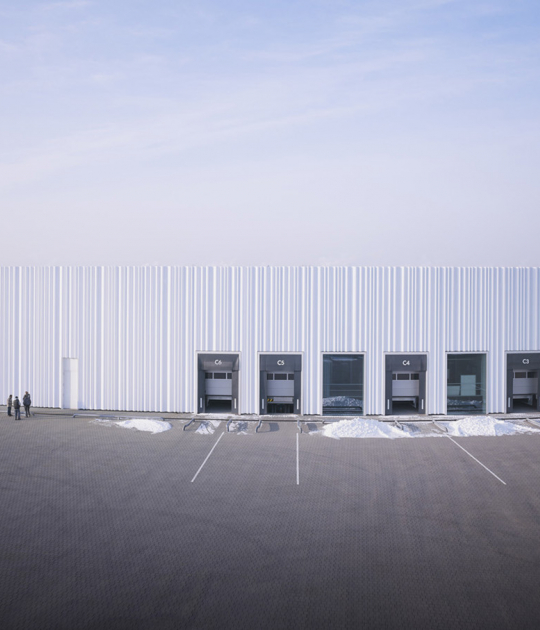Vitra Slide Tower by Carsten Höller.
On 18 June 2014, the Vitra Slide Tower by Carsten Höller has been inaugurated, adding a new structure to the Vitra Campus in Weil am Rhein. With its prominent clock at the top, it is not a building in the classical sense but a viewing tower with a slide – and a work of art that enables a new and unique experience of self and art. The 30.7-metre-high Vitra Slide Tower by the German artist provides a new accent on the Vitra Campus in Weil am Rhein.
The construction of the Vitra Slide Tower is yet another step in the thirty-year development of the Vitra Campus.
The Fire Station by Zaha Hadid is to be made more accessible to the public. The path from the VitraHaus to the Fire Station was created by Álvaro Siza as a passage with architectural ‘episodes’ and new landscaped spaces. Höller’s Vitra Slide Tower underscores the routing of the new pathway while simultaneously operating as a fully independent element.
Slides are a specific element in Höller’s work. Höller undermines accustomed forms of perception, calling on the participation of the viewer with his experimental set-ups and creating opportunities for self-experimentation. Höller’s installations are sculptures of discovery. They offer the possibility of inner experiments leading to the exploration of self. In this concept of the experiment, Höller the scientist remains present.
The Vitra Slide Tower consists of three diagonal columns that meet at the top, with a revolving clock mounted at their point of intersection measuring six metres in diameter. With a diameter of six metres, the clock is mounted at the point of intersection where the diagonally slanted columns come together at the top. It is visible from a distance and illuminated at night, but has no numbers.
Carsten Höller on slides.
A slide is a sculptural work with a pragmatic aspect, a sculpture that you can travel inside. However, it would be a mistake to think that you have to use the slide to make sense of it. Looking at the work from the outside is a different but equally valid experience, just as one might contemplate The Endless Column by Constantin Brancusi from 1938. From an architectural and practical perspective, the slides are one of the building’s means of transporting people, equivalent to the escalators, elevators or stairs. Slides deliver people quickly, safely and elegantly to their destinations, they’re inexpensive to construct and energy-efficient. They’re also a device for experiencing an emotional state that is a unique condition somewhere between delight and madness. It was described in the fifties by the French writer Roger Caillois as “a kind of voluptuous panic upon an otherwise lucid mind.
Álvaro-Siza-Promenade.
The Vitra Campus in Weil am Rhein is now enhanced by a new project, the Álvaro-Siza-Promenade. The promenade invites visitors to stroll along a unique walkway in the public area of the Campus, with various stations leading from the VitraHaus to the Fire Station by Zaha Hadid.
The so-called Álvaro-Siza-Promenade occupies a length of 500 metres. It consists of an asphalt pathway bounded by two-metre-high hornbeam hedges. In some parts, the hedges flank the path in a linear arrangement while other sections widen and open up to create green spaces. Siza chose hedges to illustrate the changing of the seasons. These are paired with hard, unchanging materials, as can be found in the earlier factory building by Siza: Dutch brick and Portuguese granite. The repertoire of forms and materials is reduced to a small number of elements.
The pathway is syncopated with ‘episodes’ – distinctive sequential settings that offer a variety of unique spatial experiences. In the first phase of development, these include an S-shaped common area framed by hedges, the Vitra Slide Tower by Carsten Höller and an archaic-looking double chamber formed from interpenetrating brick and granite walls. The promenade is like a pilgrimage route marked by multiple stations, simultaneously evoking English gardens with its various ‘follies’. With the individual architecturally expressed elements, Siza counters the Romantic idea of an indistinguishable melding of nature and architecture – landscape and geometry follow their own laws but, as is typical of Siza’s work, find their way to a state of balance on a higher level.
CREDITS.-
Name.- Vitra Slide Tower.
Architect.- Carsten Höller.
Engineering drawing.- Wiegand.
Engineering drawing "clock".- Perrot Turmuhren und Läuteanlagen / Nordlicht.
Portrait of Carsten Höller.- John Scarisbrick.
Name.-Álvaro-Siza-Promenade.
Architect.- Álvaro Siza.









































